SuperBraid
Topwater Transitions for Bass from Spring to Fall
 The changing of the seasons oftentimes makes it is necessary to modify fishing approaches in order improve fish catching opportunities. Like with any other lure type, changing up topwater presentations from spring through fall can lead to catching more bass as they shift their focus toward different types of prey and forage eaten with each of these seasons. Yo-Zuri hardbaits are a great option to consider for these necessary seasonal changes as they offer a host of different topwater lures and patterns to fit whatever situation with which the fish present us.
The changing of the seasons oftentimes makes it is necessary to modify fishing approaches in order improve fish catching opportunities. Like with any other lure type, changing up topwater presentations from spring through fall can lead to catching more bass as they shift their focus toward different types of prey and forage eaten with each of these seasons. Yo-Zuri hardbaits are a great option to consider for these necessary seasonal changes as they offer a host of different topwater lures and patterns to fit whatever situation with which the fish present us.
Spring
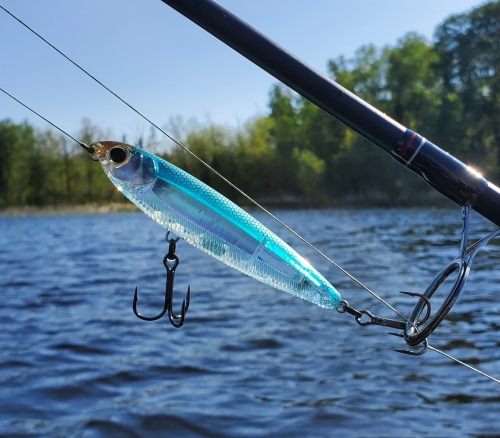
The Yo-Zuri 3DB Pencil is one of my favorite springtime lures as the fish are getting aggressive and ready to feed heavily after being hunkered down by several months of winter. These Pencils are big enough to get a fish’s attention as they prepare for the upcoming spawn, and they can be worked slow enough in the case that some fish might be more lethargic during cold front conditions. If the water and/or air temperature is lower than 50 degrees, I like going with a straight twitch and pause retrieve while using a 4” Pencil. Moving the lure 1-2’ at a time slowly forward and then pausing for up to 10 seconds can be highly effective. The pause is the key because that is when many fish will either strike or position themselves right under the lure to strike it when it starts moving again. After air and water temperatures supersede 50 degrees, then it is time to go with the classic “walk-the-dog” style retrieve where the lure moves from side to side while using a 5” Pencil. Warmer surface temperatures in spring can mean more and bigger minnows swimming in schools near the surface or in shallower bays, and when that happens, the aggressive nature of the side-to-side movement can elicit strikes because of predators already looking up and feeding on bigger active minnows.
Summer
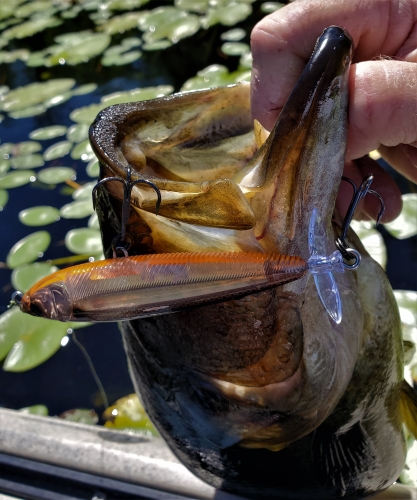
Once surface temperatures exceed the low 60s, we often see a significant increase in the amount of active bug life on the water. One specific insect that I look for during the summer months is dragonflies. When I see dragonflies, I switch from the Pencil to the Yo-Zuri 3DB Prop. The key to the Prop is that it has a plastic propeller which simulates the sound that a dragonfly makes when it is flapping its wings on top of the water. This lure can be used effectively from sunup to sundown, even when it is extremely sunny and calm, because of the presence of dragonflies. A general retrieve that I like to use is to cast the 3DB Prop parallel to emergent weeds that are adjacent to submergent vegetation and use a start-and-stop retrieve. I like to cast the lure, let it sit for 5-10 seconds so that fish can begin keying in on its silhouette right from the start of the cast, and then I go with anywhere from 1-4 cranks of the reel handle. The goal is to get the plastic prop to sound like a dragonfly’s wings flapping on the water, so sometimes reeling slower is necessary to make sure they can target the lure and eat it. Waiting to feel the fish’s weight during the strike will be paramount to improve the number of fish being hooked because simply going by sight might lead to pulling the lure away from the fish.
Fall
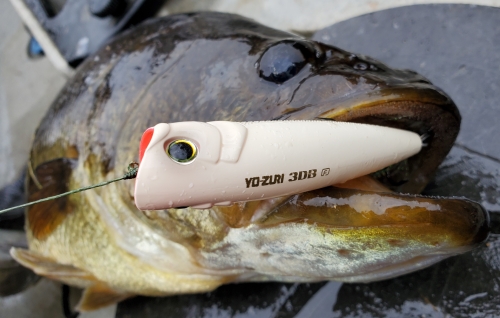
Fall is one of my favorite times of year to use topwaters as bass are hungry and feeding heavily in preparation for the upcoming long winter months ahead. The key to fall strategies for topwater lures is that I go by the first hard frost of the year versus when the calendar indicates the beginning of this season. Sometimes this happens in late August and sometimes it occurs in the at the end of September. My favorite way to pursue bass in the fall is with a Yo-Zuri 3DB Popper. I have found that using heavier line, like a 50 or even 65 lb braid, can be useful when tied directly to Poppers this time of year because I like to cast them right into any remaining emergent weed cover (even if it is dead due to frost) and retrieve it out over submergent weeds. Poppers work great in late fall as they offer a larger profile meal with little energy expenditure needed to chase them down. The Popper retrieve in fall is all about slowing things down and being patient. A cast usually entails letting the lure sit for up to 20 seconds or more after hitting the water, twitching the lure slowly 1-4 times so that it gurgles instead of splashes, and then pausing up to 20 seconds again. Using Poppers in late fall is often a case of the adage, “less is more,” when it comes to movement and noise on top of the water.
Being versatile with topwater hardbaits and adjusting the lure used based on the season can reap significant improvements in the numbers of fish that are landed. If you are looking for some exciting explosive bass action during the transitions from spring through fall, then casting an assortment of Yo-Zuri Pencils, Props, and Poppers is well worth your effort!
Mark Maule
Western Striper Success!!! -by Manuel Saldana Jr.
The Striper fishing out in the west coast is on FIRE!!!! Want to increase your chances at have a day on the water that will make memories for a lifetime, here is some helpful tips on what I prefer to do and the set up I rely on!
My rod and reel choices are the following:
Rod is a 7’6″ heavy in power with a fast action tip.
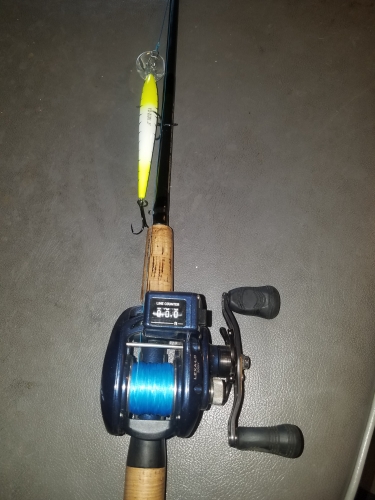
The reel is a 300 size conventional reel with a line counter. Line counters are a must because this helps us out as a guide to know how far everyone’s line or lures are.I prefer to spool it up with 30lb Yo-Zuri SuperBraid in the Blue color pattern.
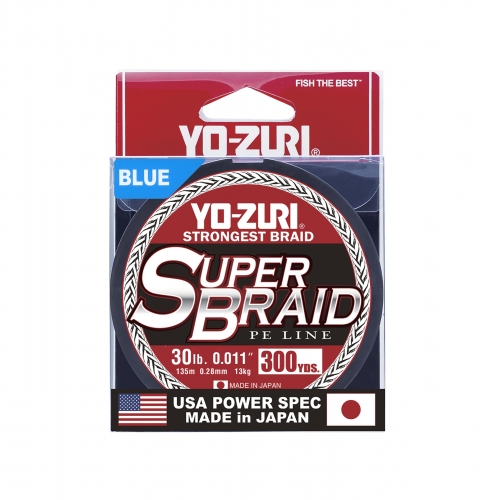
Weather conditions that are most favorable are Mid-March thru early summer, but this year throughout April and May the weather was normal morning temp 45 degrees and a high temp of 74 degrees throughout the day but the main issue we have faced is the water temperatures of 50 to 52 degrees. Our normal water temperatures are 55 degrees in mid-March and approximately 60 degrees in mid-April. It took a while to figure it out, we had Spring weather temperatures but winter water temperatures due to all the snowpack in the Sierra’s.
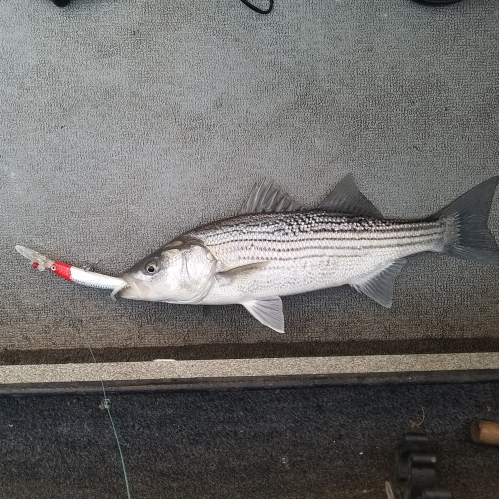
Most effective techniques were drifting upstream with deep diving floating Yo-Zuri Crystal 3D Minnow lures or the Yo-Zuri Crystal Minnow Deep Diver Walleye series lure. I recommend trolling upstream at 3 to 4 MPH. Trolling at higher speeds make these stripers react to our lures, and with the colder water temps you had to get the lures right in their face because they were lethargic.
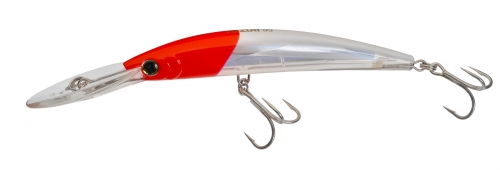
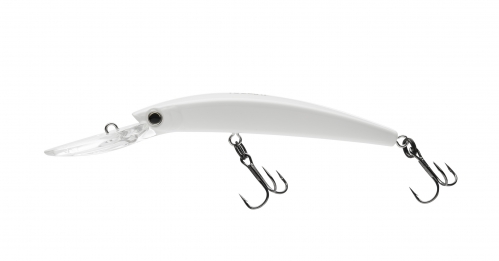
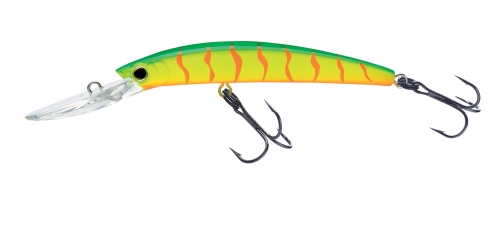
Hot baits were the standard deep diving floating Yo-Zuri Crystal 3D Minnow in Redhead/White body. This lure, for many years, has been the ‘go-to’ it comes to catching stripers. In the freshwater Deep Diver Crystal Minnow Walleye series lures the solid white has been hot for us. The bite is so good that it is almost like the stripers have never seen this lure before and they flat out couldn’t resist it! I believe the very tight wiggle the Crystal Minnow action has in the water mimics most live bait in many bodies of water such as Shad, or Pike Minnow. Another hot suggestion is the Deep Diver Walleye Series in the Hot Tiger color.
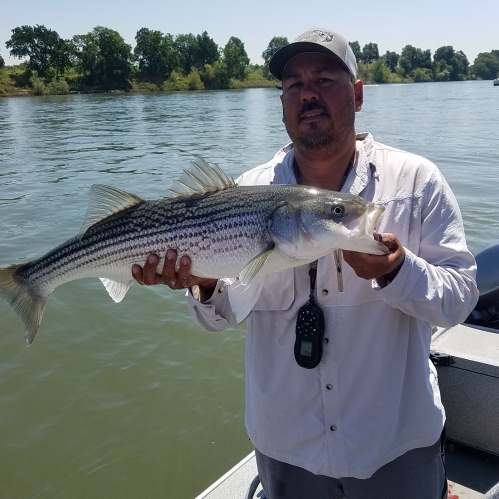
One tip I can pass on to anglers that will help them be successful is to remove the split ring that comes in the package tie a size 54 duo snap lock to your braid the attach it directly to the bait. This helps the lure run true, plus it makes easier to change out your lures as well. Also, make sure you add a trailer worm to your trailing center hook; it helps the lure get an even tighter wiggle.
Yo-Zuri Prostaff angler Brandon Cobb Captures his first W
 Fishing as a professional bass fisherman comes with a lot at stake. It can be financially trying, emotionally exhausting, physically demanding, but can all pay off when the plan comes together. Every angler out there has one goal in mind; to WIN! But what if you are in front of your hometown crowd? The people that saw you grow-up, the friends you’ve known your whole life, your wife, your parents and grandparents, all your family, what if you were the angler everyone had their eye on through-out the week? Does the stakes of winning get higher? Is there more added stress? Do you expect more from yourself? Well that was exactly the cards dealt to Yo-Zuri Prostaff angler Brandon Cobb last week on Lake Hartwell for the Bassmaster Elites Series event in South Carolina.
Fishing as a professional bass fisherman comes with a lot at stake. It can be financially trying, emotionally exhausting, physically demanding, but can all pay off when the plan comes together. Every angler out there has one goal in mind; to WIN! But what if you are in front of your hometown crowd? The people that saw you grow-up, the friends you’ve known your whole life, your wife, your parents and grandparents, all your family, what if you were the angler everyone had their eye on through-out the week? Does the stakes of winning get higher? Is there more added stress? Do you expect more from yourself? Well that was exactly the cards dealt to Yo-Zuri Prostaff angler Brandon Cobb last week on Lake Hartwell for the Bassmaster Elites Series event in South Carolina.
How did Brandon do? He never even flinched and got the job done; winning his first Bassmaster Elite Series event in his career and taking home a $100,000 payday.
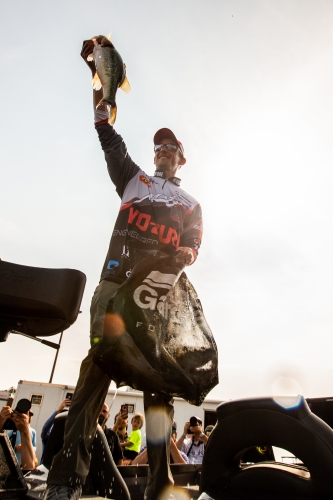
Brandon grew up in South Carolina and has fished Lake Hartwell his whole life, so knowing the lake was no problem. Making sure he didn’t let history interfere with his ability to fish clean and strong to capture the win; that was the difficult task. The Yo-Zuri pro knew he needed to stick to one area of the lake that was notorious for big bedding fish. He stuck to his plan and stayed calm.
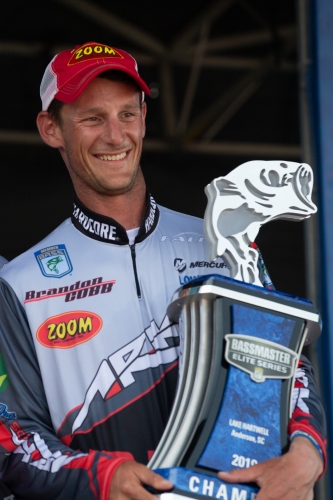
Brandon is a well-known angler that prefers to burn the bank and cover as much water as he could throwing moving baits. But, when the springtime hits and water is clear; the best way to catch them is with a spinning rod. Brandon threw a wacky worm throughout the tournament but still managed to cover as much fishable water as he could, even at times revisiting areas through-out the tournament days as fish continued to move up in his primary areas.
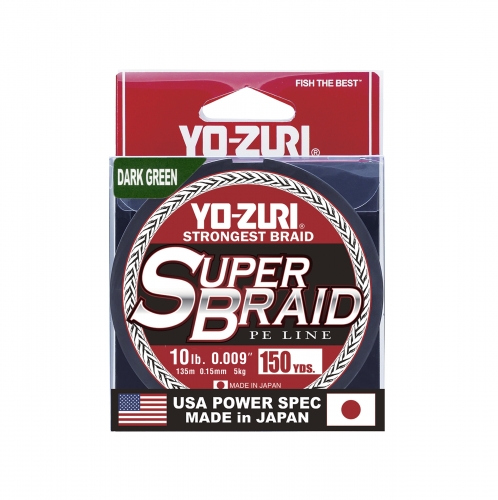
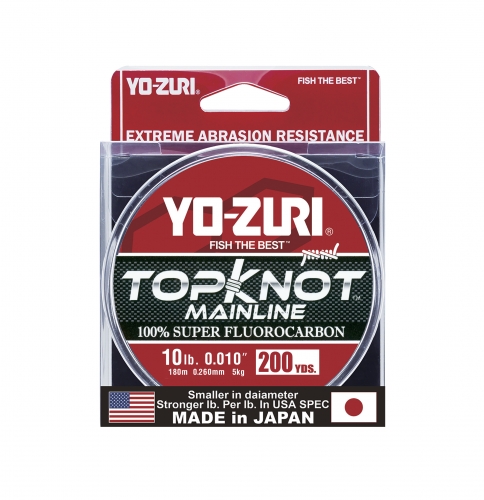
Brandon’s arsenal of attack was a 6’10 medium action spinning rod, 2500 size spinning reel, Yo-Zuri 10lb SuperBraid with a 10lb Yo-Zuri Topknot Fluorocarbon leader. Brandon was using this set up to throw a wacky worm to make long casts and catch cruising largemouth in bedding areas. Occasionally he would slow down and throw a shaky head for fish that were locked onto a bed, but most of the fish he weighed in were cruising shallow.
Late Winter Offshore Mahi Bite Picking Up!!! –Matt George
 Matt George, one of the craziest but respected personalities to the Yo-Zuri family. Matt grew up in the northeast US, but has called Florida home for several years now. When not traveling for business all over the world, he spends his down time wisely fishing inshore and offshore.
Matt George, one of the craziest but respected personalities to the Yo-Zuri family. Matt grew up in the northeast US, but has called Florida home for several years now. When not traveling for business all over the world, he spends his down time wisely fishing inshore and offshore.
“To me, I don’t care what I am catching as long as I am on the water. But lately the offshore bite has been really picking up. Following a strong pattern lately is turning into more success on the water. Let the birds help you find the bait, let the bait be your GPS, and bring on the exhilarating fight that lies before you.”
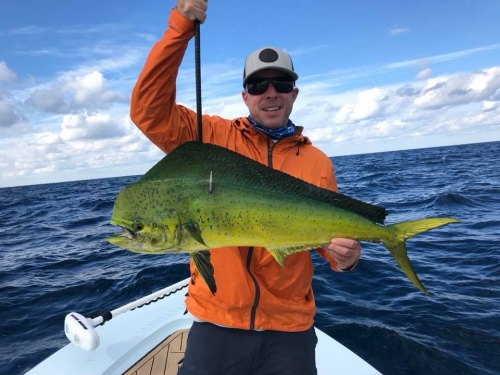
Recently, Matt is spending more time chasing the offshore bite as it is picking up. As winter is coming to a close in south Florida, the bait abundance is increasing and so is the bite.
“Right now I am hitting the water as early as possible and making a 8-12 mile run out. The key depth is anywhere between 100-200 feet. That may seem like a lot, but in your search for lurking Mahi it is easy to eliminate water quickly. Once you find that sweet spot, it is all easy pickings at that point.”
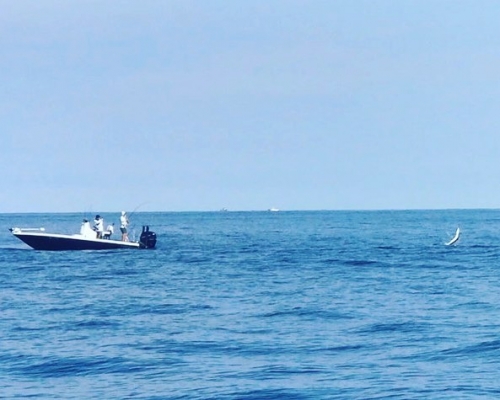
To duplicate what Matt is doing, you have to find the water that will most likely have bait, again Mahi have huge appetites and are predators. Once you find the bait you can find the fish. Along with the right amount of depth, Matt suggests looking for the temperature changes. This little subtlety could be key, but also the any irregularities in the water. Weed lines, cleaner water, dirties water, whatever may appear different out in the ocean could be the ticket. From there just find the bait which is usually accompanied by diving birds.
“The added bonus right now is on top of the Mahi I am catching, I am also finding a mix of Sailfish, again one of favorite species to target. Recent trips I am averaging 3-4 keeper Mahi and about the same number of sails. The days out there have been really fortunate and exciting!”

Matt is using a 2-way approach to targeting his catch. The traditional trolling method and topwater have paid off the best. For the trolling methods, he is rigging live bait on 30lb Yo-Zuri Blue SuperBraid with 30lb TopKnot Fluorocarbon Leader. The topwater he has been using is the Yo-Zuri Hydro Popper on a spinning outfit with the same line and leader. For the popper, Matt emphasizes to always use a loop knot when adjoining your leader to a topwater bait. This always creates the best action on the water.
Targeting Peacock Bass in South Florida with a Yo-Zuri Crystal Minnow -Robert Di Nino
 Living is South Florida, I feel blessed to have so many species of fish within a short drive from home. Most of these prized fish can also be caught from the shore. My favorite fresh water fish is the Butterfly Peacock Bass. The Peacock Bass will be found from South Miami to Palm Beach since they cannot tolerate water temperatures below 60 degrees. As crazy as it sounds, we still see cooler temperatures here in Florida.
Living is South Florida, I feel blessed to have so many species of fish within a short drive from home. Most of these prized fish can also be caught from the shore. My favorite fresh water fish is the Butterfly Peacock Bass. The Peacock Bass will be found from South Miami to Palm Beach since they cannot tolerate water temperatures below 60 degrees. As crazy as it sounds, we still see cooler temperatures here in Florida.
.jpg)
Target them in canals, ponds, and lakes, and specifically in shady areas around bridges, culverts, canal intersections, bends, dead ends, and near fallen trees. They feed in the shallow water adjacent shorelines. When I am specifically targeting the Butterfly Peacock Bass, my go to lure is the Yo-Zuri Crystal Minnow. However, whether you are targeting largemouth and peacocks in fresh water or snook, tarpon, and jacks in saltwater, fishing from the shore or your boat, the Yo-Zuri Crystal Minnow truly does it all.
.jpg)
My go-to set up is the 3.5 inch suspending in the bronze color on a medium heaving spinning rod with 20lb Yo-Zuri SuperBraid and 15lb TopKnot fluorocarbon leader if the water is clear. My favorite conditions are when there is lots of small-medium sized baitfish in the area.
A Knotted Up Mess!!! (pt. 2)
Previously we talked about different knots to tie in freshwater applications, but now let’s dive into another simpler topic. From the time I move to Florida and started getting more experienced into saltwater fishing I quickly learned that saltwater anglers stick to the basics; this includes the knots they tie. Now just like freshwater anglers, everyone has their preferences but from what I have experienced is anglers stick to the knots: loop knot and Uni-Knot for tying to their favorite Yo-Zuri lure, Uni-to-Uni Knot for adjoining main lines to leaders, and then there is the art of crimping.
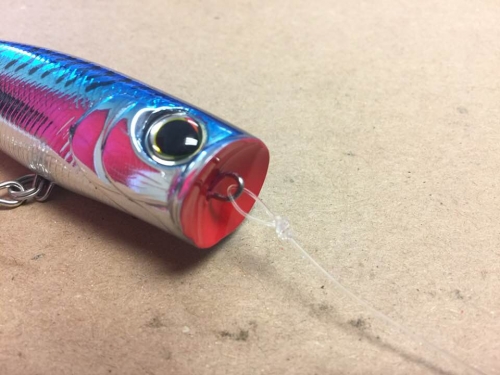
The basic loop knot is probably used the most in saltwater fishing because it is simple to tie with heavier fluorocarbon or monofilament leaders. Tying a loop knot also gives the bait the ability to move more freely in the water, which will create more action. As you can see in the photo, the actual knot is away from the lure, not at the actual line tie.
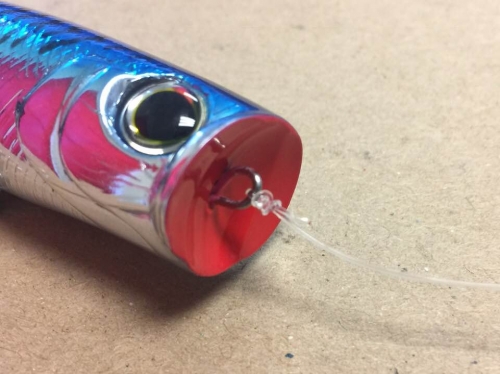
The Uni-Knot is also a favorite among saltwater anglers for the same attributes as the loop knot; it is easy to tie, works well with larger pound test line, however does not give the bait an extra moving ability. The Uni-Knot is tied directly to the lure line tie and is common to tie for the baits that just swim through the water column and resemble a bait fish.

One popular fishing technique that is shared among both freshwater and saltwater anglers, using a braided mainline to a leader material. Commonly anglers use a Uni-to-Uni knot for this application. Typically an angler will wrap the leader material four or five times around the braided mainline to form one Uni-Knot, then wrap the braid around the leader material ten to fifteen times to form the second Uni-Knot before tying them tight together. This knot is relatively small and will easily go through your rod guides when casting. The friction on the two knots is pulling against one another so the Uni-to-Uni Knot will hold up well.
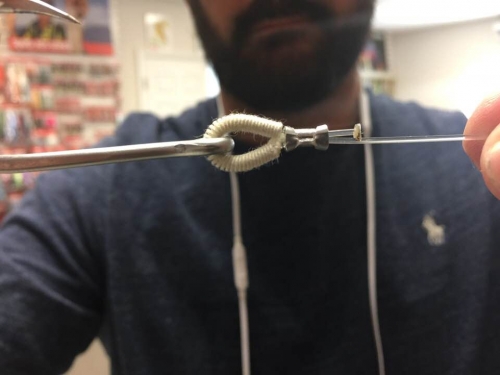
Finally, another form of knot tying that requires tool is not really a knot: crimping!!! Crimping is something a lot of saltwater anglers will use for tying on lures with heavy and large test line. Commonly anglers will implement a crimping technique when using 80lb test or larger; something for fishing to beat world records!!! Crimping tools required are: Crimpers, a Crimp, Chaff Tubing, and of course your favorite Yo-Zuri lure or one hook for live bait fishing. To perform this properly you will want to: feed the mainline through the crimp and chaff tubing, go around the eye of the lure, and feed through the crimp again. It is suggested that pull all the components as far down as you can but still leave a little room in case the mainline does slip a little. This is very common anglers that are using live bait with larger leaders and trolling bait (Yo-Zuri Bonita and Mag Speed Vibe are common examples).
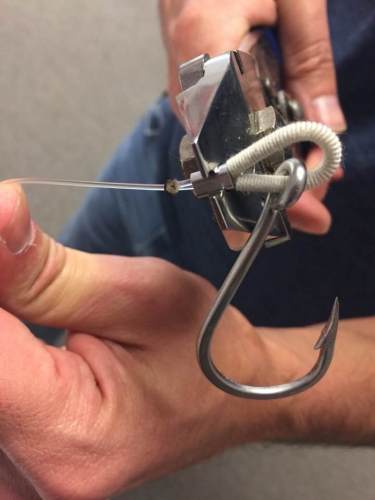
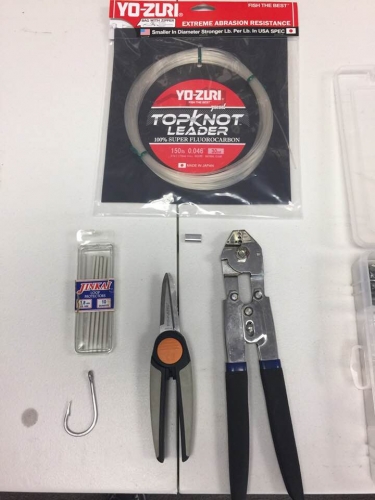
A Knotted Up Mess!!! (pt.1) –by Theron Asbery
Here is an on-going topic for debate in fishing; what knot to tie and when?
The number of knots out there to use and why they are better than the rest, is about as spread out as the number of different hardbaits on the market. For some anglers, they are very particular and picky about their knots. Some use a knot their grandpa taught them how to tie, and grandpa knew everything. Some use a particular knot that they used to win a tournament. Others use a certain knot because it has never broken on them. Finally, there is the anglers that tie any knot that the spirit moves them to tie; whatever the case may be, there is a lot of options.
I’ve spent ten years as a competitive bass angler, five of which have been competing on the FLW Tour. Here is my approach to the different knots out there and when to use them. The first piece of advice I can give every angler out there, keep it simple! I stick to three basic knots in my fishing arsenal and I have yet to find a reason to change. I’ve also added some value from Yo-Zuri prostaff members to help increase the incentive behind the way I like to do things.
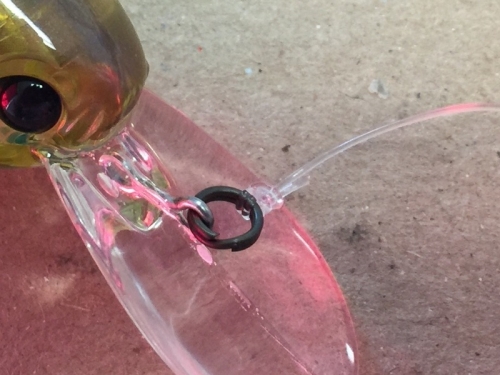
The first knot is the Palomar knot, probably one of the easiest but also one a lot of anglers have controversy over. Growing up in Oklahoma and fishing a lot with my dad, the Palomar knot was the first knot I learned to tie. However, I did break off a lot, but it was the only one I knew how to tie. It was not until I started competing in tournaments and reading a lot of article in magazines did I start learning how to tie different variations. The Palomar is still a knot I depend significantly on when fishing with Yo-Zuri Superbraid.
“The Palomar knot is as old as my fishing career. In Florida we fish a lot of grass, and I think the Palomar knot favors the best. Although it has a tendency to cut itself when tied with fluorocarbon, I think it holds the best strength with braid. Also it’s a smaller knot which cuts down the tendency on your bait getting hung up on debris in the water.” –Mike Surman, FLW Tour pro & Yo-Zuri prostaff member
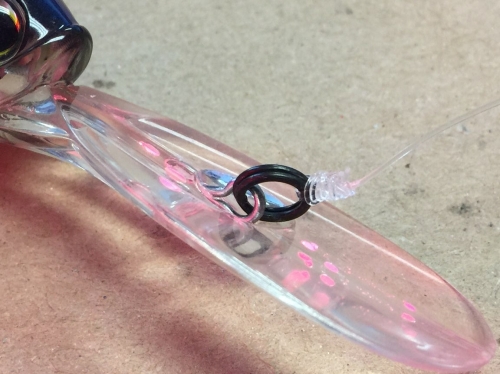
The knot I rely on 90% of the time is the San Diego Jam knot, or as some like to call it “the Jam knot”. This is the knot I especially tie when throwing Yo-Zuri crankbaits such as the 3DB Deep Crank or 3DR Mid Crank because both are worked especially well when in contact with wood or rocky bottoms. The amount of abuse you put your knot and line through in this scenario is endless, so a quality line and knot is paramount. Yo-Zuri TopKnot fluorocarbon is the best on the market and I’ve found the best knot to tie to hold up well and be the strongest is the San Diego Jam. It has three tag ends and pretty simple to tie, however the key to tying it correctly is like most any other knot, make sure to wet it down before you cinch it complete.
“Most of the anglers I know are tying the San Diego Jam for everything. I’ve never had that knot slip or break on me. In my line of work if it isn’t broke, then don’t fix it.” –Clent Davis, Yo-Zuri prostaff
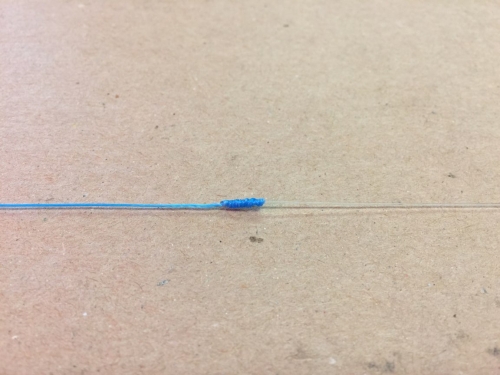
Finally, there is the knot everyone has to use to connect a mainline to a leader. Personally I like the Alberto knot. Again, this was the first knot I learned to tie when adjoining two different lines and it has not failed me yet. It is a pretty thin knot and holds up well for smaller diameter braid and fluorocarbon. It is a knot that wraps the mainline up to sixteen times around the leader material, so it has an excellent hold when all cinched down.
“I’ve found the quickest and strongest conjoining knot to tie, especially when finesse fishing, is the Alberto knot. I’ve caught ten pounders on shakey heads before, and never once had a single issue with the Alberto knot.” –Luke Clausen, Yo-Zuri prostaff & Major League Fishing BPT pro
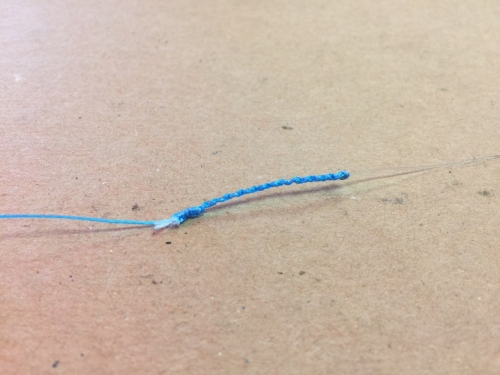
However, there is a new knot that has really shown itself and made a name for itself among anglers on the tour level; the FG knot. This is knot is relatively difficult to tie and will take a lot of practice to getting the hang of. It was originally designed by tarpon and redfish anglers in the state of Florida but has eventually made its way to the freshwater scene. Again, this is a very thin knot and has a great strength. I would recommend searching YouTube and seeing some different videos on how to tie it. It works very similar to a Chinese Finger Trap, I’ve even heard of guys using it for Crappie fishing and not having to retie for months and months at a time.
“The FG Knot is my favorite when tying braid to fluorocarbon. Although I recommend taking your time and sitting down in the bottom of the boat to tie it, I’ve exclusively started depending on it.”- Brandon Cobb, Yo-Zuri prostaff and BASS Elites Series Angler
Here is just a couple examples of the different knots out there anglers love to use. I have my personal favorites, and every angler out there has their own. No matter what an angler prefers to tie, the key is to have confidence in the knot you rely on!!!
Next week we will feature pt.2 which will cover knots preferred in saltwater fishing. Think it is the same as freshwater???
Kayaking in Paradise – Lance Clinton
The weather is just getting perfect and the bite down here in Costa Rica is on!!! Down here in my little piece of paradise I am fishing every day and have dream trips catching Mahi, Cubera, Wahoo, and Rooster. The Mahi are not on a full run yet where I am fishing, however I am catching the occasional few. The Cubera and Wahoo bite is going crazy right now, and fishing for them out of a kayak adds to the excitement.
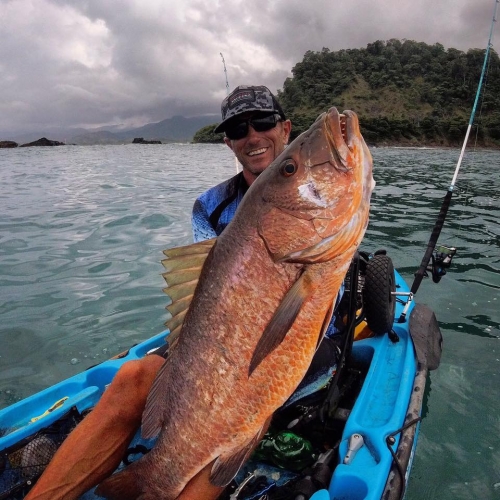
I am finding myself having to paddle about 2 miles off shore right now to locate a solid bite. I start every morning around 5:00 and am usually back at the dock in time for lunch. By then anyway, my arms are so tired from fighting fish all morning I barely find the strength to paddle back in. Typically the best days have been in a post-frontal, cloudy condition. This weather pattern will generally create more current coming out of the rivers and stir up the bait fish. This creates a feeding frenzy for the fish and a perfect time to catch multiple trophies each day.
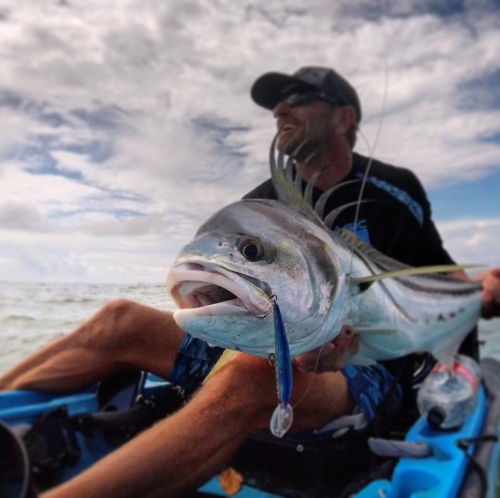
My typical set up is a 7’ rod with a big spinning reel on it. I will advise anyone to not go cheap on a spinning reel, the general rule is the more you invest in a quality spinning reel the more likely you are to land more fish. A better quality spinning reel provides a better drag system and anyone that fishes offshore knows, fish will rip your drag a lot in a fight. Because of the larger spools on spinning reels offered today in the market I am able to get away with higher pound Yo-Zuri SuperBraid. Typically I run a 65lb Superbraid with a 40-60lb clear Yo-Zuri TopKnot Leader. The heavier line is what I trust when fishing shallower around boulders and rough bottom. You just have to let the fish tell you where to fish to catch them, and this is usually following the bait.
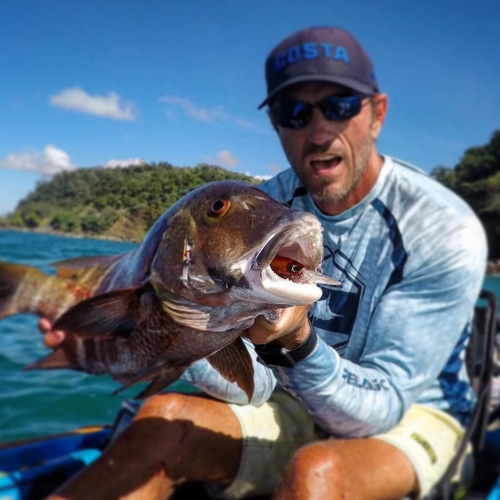
When thinking about bait selection, I generally follow this rule of thumb: “anything will work as long as it’s Yo-Zuri.” My box is usually loaded down with Hydro Minnows, Crystal Minnows, and Mag Minnows. Sometimes in the morning I will mix in using the 3D Popper on very calm mornings. The retrieve varies based on the species; Roosters seem to prefer a very fast action retrieve, but Cubera and Wahoo seem to really prefer the slow retrieve. I generally cast a bait out and rip it violently but give it long pauses in between rips; lately it seems like the longer the pause the better. There is no question when you get a bite so pay attention!!!
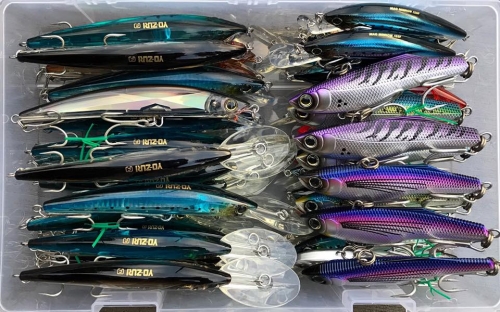
If you’re planning a vacation soon and are angler; you’re crazy not to have Costa Rica on your bucket list. Make sure to stop by your local tackle store to get a few Yo-Zuri lures on your way. Happy fishing and see you out there!!!!!
